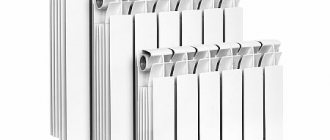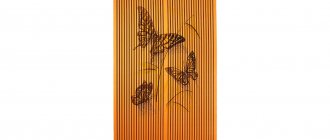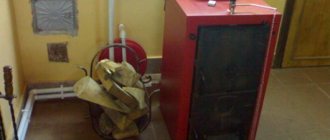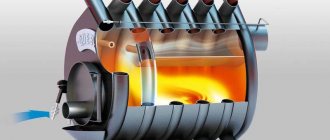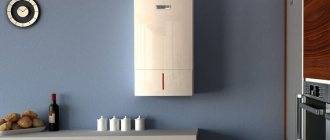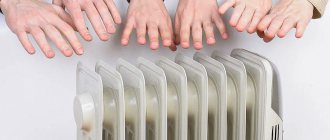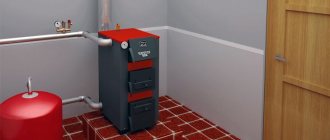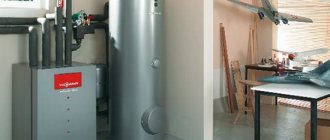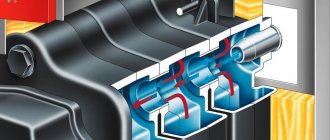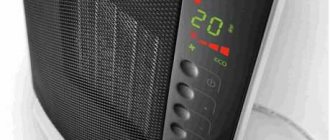When you are going to buy heating radiators, you need to prepare in advance. Just the desire to purchase devices is not enough. You need to study the technical characteristics and parameters of radiators to find out which heating radiators are best - specifically for your heating system.
You can compare completely identical battery models in appearance, but in terms of heat transfer and power, they can differ noticeably. Here everything will depend on the material of the radiator and its design features, the internal capacity of the batteries, and the method of connecting them. That is why, when you choose which heating batteries are best, you need to prepare and have some knowledge.
Radiator
Rating of the TOP 20 best heating radiators for apartments and private houses for 2021-2022
| TOP 4 best heating radiators for apartments by price/quality for 2021-2022 | ||
| 1 | Royal Thermo PianoForte 500 | Find out the price |
| 2 | Rifar Supremo 500 | Find out the price |
| 3 | Buderus Logatrend VK-Profil 22 500 | Find out the price |
| 4 | Royal Thermo Vittoria 500 | Find out the price |
| TOP 4 best bimetallic heating radiators | ||
| 1 | Royal Thermo BiLiner 500 | Find out the price |
| 2 | Rifar Monolit 500 | Find out the price |
| 3 | Global STYLE PLUS 500 | Find out the price |
| 4 | Rifar Base 500 | Find out the price |
| TOP 4 best aluminum heating radiators | ||
| 1 | Global ISEO 500 | Find out the price |
| 2 | Royal Thermo Indigo 500 | Find out the price |
| 3 | Rifar Alum 500 | Find out the price |
| 4 | ROMMER Al Optima 500 | Find out the price |
| TOP 4 best steel heating radiators | ||
| 1 | Axis Classic 22,500 | Find out the price |
| 2 | Purmo Compact 22 500 | Find out the price |
| 3 | Arbonia 2180 | Find out the price |
| 4 | Kermi FKO 22 500 | Find out the price |
| TOP 4 best cast iron heating radiators | ||
| 1 | Ogint 500 | Find out the price |
| 2 | Santekhlit MS 500-140M | Find out the price |
| 3 | Ogint 300 | Find out the price |
| 4 | STI Nova 500 | Find out the price |
Content
- Aluminum radiators
- Steel radiators
- Bimetallic radiators
- Cast iron radiators
- How to choose heating radiators?
- Calculation of the number of radiators and power
- Useful tips for choosing radiators
One of the key elements of the heating system of any home are heating radiators. These are devices in which water, antifreeze or oil, heated to a given temperature, continuously circulates inside. Properly selected and installed, they will certainly provide warmth to your home, and therefore its comfort, even in the most severe winter cold. If during the heating season you are not satisfied with how the batteries heat, then the utility companies should not always be blamed for this. Perhaps it’s just time to replace the installed devices with more modern ones with improved characteristics. Moreover, it’s worth taking care of this in the summer.
How to choose a heating radiator?
You need to pay attention to the material from which the product is made, the heat transfer coefficient, the connection method and the highest operating pressure.
Radiators are distinguished:
- Steel . They have good heat transfer rates, simple design and long service life, and are easy to install. But steel products can suffer from corrosion, cannot cope with the pressure of the central heating network, and their paint quickly peels off.
- Cast iron - not afraid of corrosion and high pressure. They heat the room well, are easy to install and have a long service life. It takes a long time for the system to warm up, but it also takes about an hour to cool down. They are afraid of sudden water hammer, they are bulky and of the same type.
- Aluminum ones are lightweight, inexpensive, have an aesthetic appearance and high heat transfer. The room heats up quickly. A pressure of 10-16 atmospheres is optimal. The main disadvantage is high chemical reactivity, so an oxide film is required for the barrier. Poor quality water can cause corrosion. The kit includes a valve for air venting.
- Bimetallic ones will last 20-50 years thanks to the combination of steel and aluminum. The steel core increases strength because it is resistant to high pressure and sudden hydraulic shocks. The outer aluminum coating helps distribute heat as quickly as possible. The main disadvantage is the high cost.
A lot is not a little
A common mistake homeowners make is selecting the size of heat exchangers according to the width of the window opening.
Feel free to leave free space by installing the required number of radiator links according to power calculations.
If you overdo it with the number of sections, you will get dry air, stuffiness or drafts from constantly open windows.
Important ! Do not install one unit of many links in a room: long structures take longer and heat up unevenly. It makes more sense to connect two sets with fewer links.
Saving on radiator sections also negatively affects the microclimate of residential premises. The cold in the rooms will force you to add firewood to the firebox or increase the supply of liquid fuel to the boiler. Operating a “water heater” at peak loads will reduce its service life and lead to excessive consumption of fuel and money. Maintain balance when choosing radiators.
What to look for when choosing a heating radiator?
With autonomous heating in a private house or cottage, you can save money and take a budget aluminum or steel radiator, but this is an unaffordable luxury when interacting with public utilities, which apartment owners are forced to deal with.
On the upper floors the pressure is less, so you can even get by with steel, but we still recommend consulting about the operation of central heating.
Since you will have to periodically deal with changes in pressure and temperature, it is better to focus on bimetallic radiators. Please note that draining water due to technical work implies the occurrence of corrosive processes inside the batteries.
At the same time, everything depends not only on the material, but also on the quality of the equipment.
When choosing a battery for heating an apartment , also adhere to the following recommendations:
- The pressure indicated in the passport must exceed the OS by one and a half times. If your heating system requires more pressure than the battery can handle, you risk additional costs. For Khrushchev buildings this figure is usually up to 8 Atm, and in panel high-rise buildings it can reach 15 Atm.
- The maximum temperature for foreign manufacturers is often 90 degrees, which is not enough for our winters;
- The number of sections is calculated either by area or by volume.
Calculation of the number of sections
The number of sections is calculated using a formula or in an online calculator.
To select the number and type of heating radiators, a thermal engineering calculation is performed. Initially, it is assumed that heating a room with an area of 1 m2 and a height of 3 m will require 1000 W of thermal energy. To determine the amount of heat for specific conditions, correction factors are introduced.
If the room height is more than 3 m, the calculated power of the radiators is increased by a multiple of the excess of the conventional one. In a corner room with two windows, the average battery power is increased by one and a half times. The change in coolant temperature is important. When it decreases by 10 degrees, the power of heating devices is increased by 15-20%.
Their heat transfer depends on the connection diagram of radiators. Traditionally, hot coolant is supplied to the upper side inlet, the reverse movement occurs through the lower outlet, located diagonally from the upper one. The use of other schemes leads to heat loss of 5-10%.
Factors taken into account when thermally calculating a room:
- Number of external walls. The more there are, the higher the heat losses and the higher the required temperature. In interior spaces, heat loss will be negligible.
- The location of the walls on the cardinal points. Rooms located on the north or northeast side will require more heating. The southern and southwestern walls additionally receive heat from the sun; the rooms on these sides are well lit and heated.
- The location of the wind rose is taken into account. Walls on the windward side will cool faster.
- Minimum temperature values in the region. Choose the average indicators that occur in the coldest month of the year.
- Level of thermal conductivity of external walls. The basis is a wall made of hollow ceramic bricks two bricks thick. To obtain a comfortable temperature and reduce heating costs, the walls are insulated.
- Heat is lost through floors and ceilings. In a one-story house, additional insulation of the underground is performed and a warm attic is installed.
- Take into account the number and size of windows.
- An important parameter of thermal calculation is the number of entrance doors to the street or balcony. When they open, cold air enters the room and reduces the temperature.
This complex calculation is easy to perform using an online calculator. Such a program can be found on the Internet and, by entering the required parameters, determine the amount of heat required to heat the house.
Next, determine the number of heating sections of the radiators. The amount of heat for heating is divided by the specific thermal power of one section. Non-removable structures are counted as one section. One radiator cannot have more than 10 sections, otherwise the coolant will not heat them to the required temperature.
Specific powers for various types are given in the table.
| Radiator type | Maximum operating pressure, bar | Thermal power of the section, W | Maximum coolant temperature, 0C |
| Cast iron | 6-9 | 80-160 | 120 |
| Steel | 10-12 | 150 | 110-120 |
| Aluminum | 6-25 | 190 | 130 |
| Bimetallic | 16-36 | 200 | 130 |
Most often, owners of individual houses opt for steel and aluminum heating radiators. The principle of “price and quality” is observed here. Cast iron batteries are a thing of the past, and modern bimetallic structures are quite expensive. Their use in autonomous heating systems is impractical.
Which heating radiators are best to choose?
Thus, it is necessary to buy such equipment based on the heating system with which you will have to interact.
If you don’t know which heating radiator to buy for your apartment or house, you should pay attention to products made from different materials.
Regarding our conclusion:
- The best aluminum battery 10 sections – Royal Thermo BiLiner 500;
- A good cast iron battery for an apartment is Ogint 500;
- The best steel radiator for autonomous heating is Purmo Compact 22,500;
- Reliable radiator for central heating – Global STYLE PLUS 500;
- The best bimetallic battery is Rifar Monolit 500.
Features of the heating system in a country house
The traditional heating supply scheme in cottages and small houses is based on water heating with bottom wiring. Natural circulation is used - a slight slope for distribution pipes - or forced: with the connection of pumps.
The heating system in a separate house includes a choice of:
- boiler, electric, gas, wood or combined;
- distribution pipes made of various metals or propylene;
- heating radiators - storage tanks;
- coolant: plain water, purified or antifreeze.
Article on the topic: Bathhouse barrel com
Autonomous heating in residential premises assumes low pressure in the main pipes. Therefore, when choosing radiators, you will not have to take into account the operating pressure indicator , as is the case with centralized heating. When choosing, focus on the material, its thermal conductivity, power, service life and price.
Customer Reviews
Fedor D.
Royal Thermo Vittoria 500
done, in my opinion, well. Included with the documents is insurance: but it must be filled out in the store, with an online order you receive a blank form: but THE FACT OF Galicia insurance is a certificate of manufacturer's liability. Disadvantages: Upon leaving the delivery point, I found a rather large impact mark on the cardboard box (see photo, about 5 cm long, 2 cm deep). Most likely, they dropped it, for example, when loading/unloading it on the floor of a car, or hit it on a corner when they were carrying it, for example. Keep in mind that in addition to the cardboard box, the radiator is protected from the inside only by polyethylene with air bubbles. I opened the box, thank God, the blow ended up in the back of the battery in the gap with emptiness. On the back side there is a small, slightly bent section of one of the blades (see photo), but it’s not critical, it doesn’t affect anything (I hope).
Ruslan Lazarev
Rifar Supremo 500
Really cheap. The appearance is good, but this is for transportation. 12 sections in a completely cardboard box (hi rifar). Disadvantages: I was packing the radiator and one hole (as usual - out of spite) turned out. The left-hand (!) thread on the manifold. TENRAD connection kit. I pulled all the holes normally, even stronger and nothing, but here it is. I already had experience working with Rommer Optima BM 500 radiators; we bought them for my parents several years ago, so when I needed to buy radiators for my suburban home, I decided to use a company I already knew. They arrived, one box had a corner torn upon delivery, but the radiator was intact, so I didn’t refuse or replace it
Leonid Gromov
ROMMER Al Optima 500
I was pleased with both the packaging and the Optima batteries themselves. The corners and ends were laid with several layers of cardboard for reliability, the packaging arrived without dents, the batteries themselves are light, painted evenly, without burrs in the threads, and made neatly. We installed it after renovations in the apartment and have already tested it at work. The power is high, corresponds to the declared one, and does not leak anywhere. I chose a bimetallic radiator ROMMER Al Optima 500 for use in an individual heating system. The radiator is powerful, for our Russian winter and autumn. I checked the radiator in action. It does an excellent job, and is made so thoroughly that it should last a good long time. The price for such a radiator is really adequate. I wish the manufacturer was more represented in stores!
Pavel Kotov
Rifar Base 500
High quality radiator. Made very well. I hope it will last a long time. Radiator design! I had several selection criteria, in addition to heat transfer and reliability. Firstly, aesthetics. I just got rid of the cast iron monsters, why do I need a new freak in the house? Secondly, safety. Obviously, if there are children in the house, there is no need to buy the option with sharp edges. In addition, I paid attention to how easily the radiator can be cleaned of dust. The Rifar Base 500 passed the test on all counts and met all my requirements. Actually, 5 years have passed since the installation, and I am still satisfied.
Vladimir Mikhailov
ROMMER Al Optima 500
I decided to thoroughly start heating my house, since I simply had never gotten around to it. I installed these radiators in my country house. They heat well, hold heat well, and don’t smell anything. The old batteries were leaking and needed to be replaced with new ones. I didn’t go to the store, since in our city they are quite high. So I started browsing online stores. I came across a Romer Optima 500 radiator. It’s small, and the reviews are good. I ordered it for myself. They brought quite a lot. The radiators were securely packaged. I did the installation. Everything fit perfectly. I did a test run to check the joints for leaks. Everything is fine. I would like to note that the heat dissipation is good.
Andrey Bastrakov
Buderus Logatrend VK-Profil 22 500
The product corresponds to the description, heats perfectly, the heat transfer feels many times better than that of the previous Chinese analogue. In 2021, I took 2 radiators at once: one for the living room with 12 sections, one for the kitchen, 6 sections. There were no difficulties. Four years of operation is, of course, not twenty, while problems may not have appeared, but a 10-year guarantee inspires peace of mind. I don’t understand the negative reviews, either the plumbers did something wrong, or they bought some kind of fake on the market - everything works for me. As they say, “we’ll see,” but so far I don’t see any signs of failure. Before the start of the heating season, we specifically called the plumber for a consultation to check, just in case, that everything was in order. He said that everything was fine, although he advised us to replace the cast-iron batteries in the kitchen because they were getting clogged. But that's next year.
Alexander I.
Royal Thermo PianoForte 500
Availability of the product I was looking for, full consultation. At the time of purchase, the appearance was modern, well made, good heat dissipation, not made in China, 10 year warranty. After opening the package, I discovered a poor-quality coating inside the radiator, it’s clear that the drips of the coating were corrected - I noticed this because I installed it myself. The defect was on one of the three I bought. It would be nothing, but taking into account the fact that I paid more than 25 thousand for three radiators, I would recommend opening buyers packaging in the store and check the appearance.
Roman L.
Royal Thermo BiLiner 500
Advantages - high quality of manufacture and material of the battery, good packaging of the goods. The website indicated that it was made in Italy, in fact Russia. although this inaccuracy does not affect manufacturing. There are no plugs included, but this drawback is common to many manufacturers. This is not the first time I have installed such a battery. The first one has been working for about 10 years. there are no comments about it. provides better heat than a standard metal radiator, all other things being equal. When carrying out repairs, I will install the same ones in the future, there are few analogues.
Alexander M.
Rifar Monolit 500
Nice appearance, no sharp corners on the front side. One of the key advantages of the radiator is its resistance to external corrosion due to the use of special powder paint. In addition, this design provides visual appeal and aesthetics. It is unlikely that anyone will dispute the fact that the radiator fits perfectly into any interior. And, of course, the high heat transfer should not be underestimated. I stopped using air conditioning a long time ago: one small compact device was enough to provide a comfortable temperature.
Vladimir K.
Global STYLE PLUS 500
They heat 1.5 times better and faster than cast iron ms. They don’t transmit any noise (we don’t hear our neighbors through them, only through the ceiling, like people sneezing at night)) Again, the plus is that the rifar is monolithic and has no gaskets, which means they won’t leak. Unlike the classic monolith, the supremo radiator has 2 water passage channels, thereby increasing the speed and volume of heat transfer. I’m using it for the second winter and I’m happy with it. The coating did not fade or peel, unlike cheap Chinese Italian brands. better than clumsy dust collectors. I didn't find any cons. Probably their disadvantage is that they are expensive and that competitors of the domestic brand unreasonably criticize the Russian product. I can recommend it to those who freeze, as it copes with heat transfer 100%. I don’t want to advertise, but I don’t regret buying them.
Nastasya V.
Rifar Base 500
Good batteries, high quality and most importantly heat the room! The choice of radiators in Russia is very important, because climatic conditions require 6 months of cold weather. Unlike the Soviet past, when there was no alternative to heavy cast-iron batteries, modern manufacturers offer a wide selection of types of radiators. I settled on bimetal because this is perhaps the only option that combines reliability. In terms of heat transfer, there are no complaints: very warm. There are no complaints about sealing either, there have already been so many pressure surges in the system, but he doesn’t care.
Alexey Revenko
Global ISEO 500
minimalism, heat transfer is stronger than the Soviet ones! Lightweight, stylish, modern radiator. During the first winter I didn’t find any shortcomings. I bought it after the repair of the team, to replace the old Soviet ones. Before this, for some reason there were 2 batteries in the room, for 6 and 7 sections, so we decided to make 1 battery in the middle, for 10 sections. As a result, it warms even more than the old ones, although the room was always warm. So I advise you to take it (optional) with a water supply regulator so that you can sit and heat the room.
Five installation rules
When installing, take into account the correct location of the batteries and the coolant supply to them.
- If you want to save on energy costs for the boiler , install a two-pipe heating system.
Unlike the traditional “Leningradka” (single-pipe connection), you can control the temperature in each room of a private house.
- Consider the connection location of the links, leaving at least 20 centimeters on the installation side for the process connection.
- Ensure optimal convection of warm air due to the free space at the bottom and top of the autonomous heating radiators.
- Be aware that installing heat exchangers in designer niches and screens leads to a loss of heating power. Sometimes this value exceeds 25% . Compensate for “underheating” by increasing the number of sections.
- Install Mayevsky and ball valves on heating radiators This will not only de-air, but also drain water from the pipes to clean the system.
